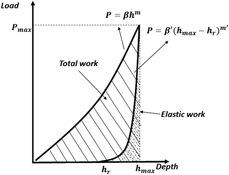Article contents
An energy-based nanoindentation method to assess localized residual stresses and mechanical properties on shot-peened materials
Published online by Cambridge University Press: 06 March 2019
Abstract

Concurrently assessing localized residual stresses and mechanical properties in cases where there are gradients in stresses and properties (such as those resulting in metallic alloys from shot peening processes) is challenging. Most indentation-based stress measurements assume uniform properties, which is not necessarily the case in this common industrial process. By using the energy envelope describing the total work of indentation by a load–displacement curve from instrumented indentation, localized residual stresses after shot peening were evaluated experimentally. A framework is developed to describe the appropriate indentation depth at which to assess properties that effectively define the volumetric resolution of the method. The residual stresses predicted via the nanoindentation experiment and energy analysis were validated with X-ray measurement of residual stresses on a shot-peened 52100 steel. The energy method can be applied directly from the indentation load–displacement curve without considering the contact area.
Keywords
- Type
- Article
- Information
- Journal of Materials Research , Volume 34 , Issue 7: Focus Section: Interconnects and Interfaces in Energy Conversion Materials , 15 April 2019 , pp. 1121 - 1129
- Copyright
- Copyright © Materials Research Society 2019
References
- 11
- Cited by




